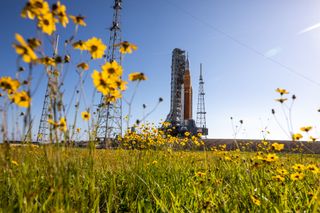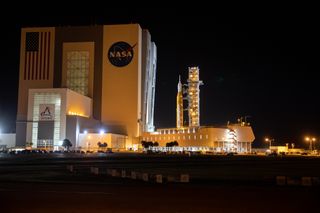NASA's Artemis 1 moon rocket returns to launch pad for crucial tests
Artemis 1's next 'wet dress rehearsal' attempt is scheduled to kick off June 19.

NASA's Artemis 1 moon mission is back at the launch pad.
Technicians at NASA's Kennedy Space Center (KSC) in Florida began rolling the Artemis 1 stack — a Space Launch System (SLS) rocket topped by an Orion crew capsule — out of the Vehicle Assembly Building (VAB) around 12:10 a.m. EDT (0410 GMT) Monday morning (June 6), once again taking the mega moon rocket on the 4-mile (6.4 kilometers) trek to historic Launch Complex 39B.
The overnight journey took about 10 hours, with Artemis 1 arriving at the pad just before 10:00 a.m. EDT (1400 GMT). Now, the vehicle stack and ground systems await another attempt to fuel the rocket and simulate a launch countdown for a critical series of tests known as a wet dress rehearsal, which is expected to begin on June 19.
Live updates: NASA's Artemis 1 moon mission
Related: NASA's Artemis 1 moon mission explained in photos
Artemis 1 will be the highly anticipated debut voyage for SLS, whose development has been marked by multiple delays and cost overruns. (Orion has flown once before, on a trip to Earth orbit in 2014.)
The mission will fly an uncrewed Orion around the moon and back in preparation for future Artemis missions, which aim to return humans to the moon for the first time since 1972. So NASA is taking every precaution to ensure the rocket's debut is successful, including opting to scrub the first wet dress rehearsal in April to allow time for further maintenance after three failed attempts to load the SLS with cryogenic fuel.
Artemis 1's first rollout from the VAB to Pad 39B took place March 17, followed by a wet dress rehearsal that began April 1. Unable to complete the full gamut of tests, NASA made the decision to roll the vehicle and its mobile launch platform (MLP) back to the VAB for repairs on April 25. Technicians addressed the root causes of the initial wet dress scrub, and they also used the time in the VAB to accelerate the implementation of other scheduled upgrades.
Get the Space.com Newsletter
Breaking space news, the latest updates on rocket launches, skywatching events and more!
During the first wet dress try, ground teams ran into problems with loading fuel into the SLS' Interim Cryogenic Propulsion Stage (ICPS), which is responsible for Orion's orbital insertion and trans-lunar injection burns. Loose flange bolts contributed to a hydrogen leak in the umbilical lines connecting the MLP to the ICPS. NASA's investigation revealed that the seals for those bolts deteriorated to a certain amount as they aged and implemented torque checks to tighten the affected hardware.
Other repairs were also aimed at addressing SLS' cryo-loading issues. A helium check valve was replaced on the ICPS, and modifications were made to the umbilical boots responsible for the quick disconnect of the MLP arms from SLS during liftoff.
With the Artemis 1 stack absent from Pad 39B over the last five weeks, upgrades at the launch complex were able to move forward ahead of schedule. Most notably, the NASA contractor supplying the infrastructure that handles and provides gaseous nitrogen at the launch pad was able to nearly double the facility's capacity by adding a second method to produce the gas.
Huge amounts of gaseous nitrogen are used during the wet dress rehearsal as well as the launch itself. For one, the gas is cycled through all of the fuel tanks and hoses on the rocket and ground infrastructure to help purge the vessel's cavities before and after fueling. The new upgrades will allow systems to reach their full design capacities and facilitate fueling tests of up to 32 hours, NASA officials said.
The upcoming wet dress rehearsal for Artemis 1 is slated to kick off on June 19 and last about 48 hours. The countdown simulation will see the rocket through actual pre-flight and fueling procedures to the moment just before engine ignition.
Related: Every mission to the moon

Ground teams at KSC will coordinate with staff in Mission Control at NASA's Johnson Space Center in Houston, engineers at the Marshall Space Flight Center in Huntsville, Alabama as well the Space Force Eastern Range at Florida's Cape Canaveral to conduct loading operations for over 700,000 gallons (2.65 million liters) of cryogenic fuel between the rocket and launch pad infrastructure.
A series of countdown rehearsals, holds and aborts, as well as different simulated weather scenarios will test ground teams' abilities to load and unload propellants through a number of different launch conditions. Several days after a successful wet dress, teams will roll the SLS and Orion back to the VAB to analyze testing data, determine the vehicle's flight readiness and hopefully begin preparing the rocket for an actual launch.
Officials at NASA have refrained from picking a firm date for the Artemis 1 mission, citing the need to review the outcome of the wet dress rehearsal, but have voiced optimism for a late-August window, which might just be possible if everything goes smoothly over the next few weeks. Should SLS hit any additional snags, NASA has preemptively published a list of future launch opportunities that run through 2023.
Follow us on Twitter @Spacedotcom or on Facebook.
Join our Space Forums to keep talking space on the latest missions, night sky and more! And if you have a news tip, correction or comment, let us know at: community@space.com.

Josh Dinner is Space.com's Content Manager. He is a writer and photographer with a passion for science and space exploration, and has been working the space beat since 2016. Josh has covered the evolution of NASA's commercial spaceflight partnerships, from early Dragon and Cygnus cargo missions to the ongoing development and launches of crewed missions from the Space Coast, as well as NASA science missions and more. He also enjoys building 1:144 scale models of rockets and human-flown spacecraft. Find some of Josh's launch photography on Instagram and his website, and follow him on Twitter, where he mostly posts in haiku.
